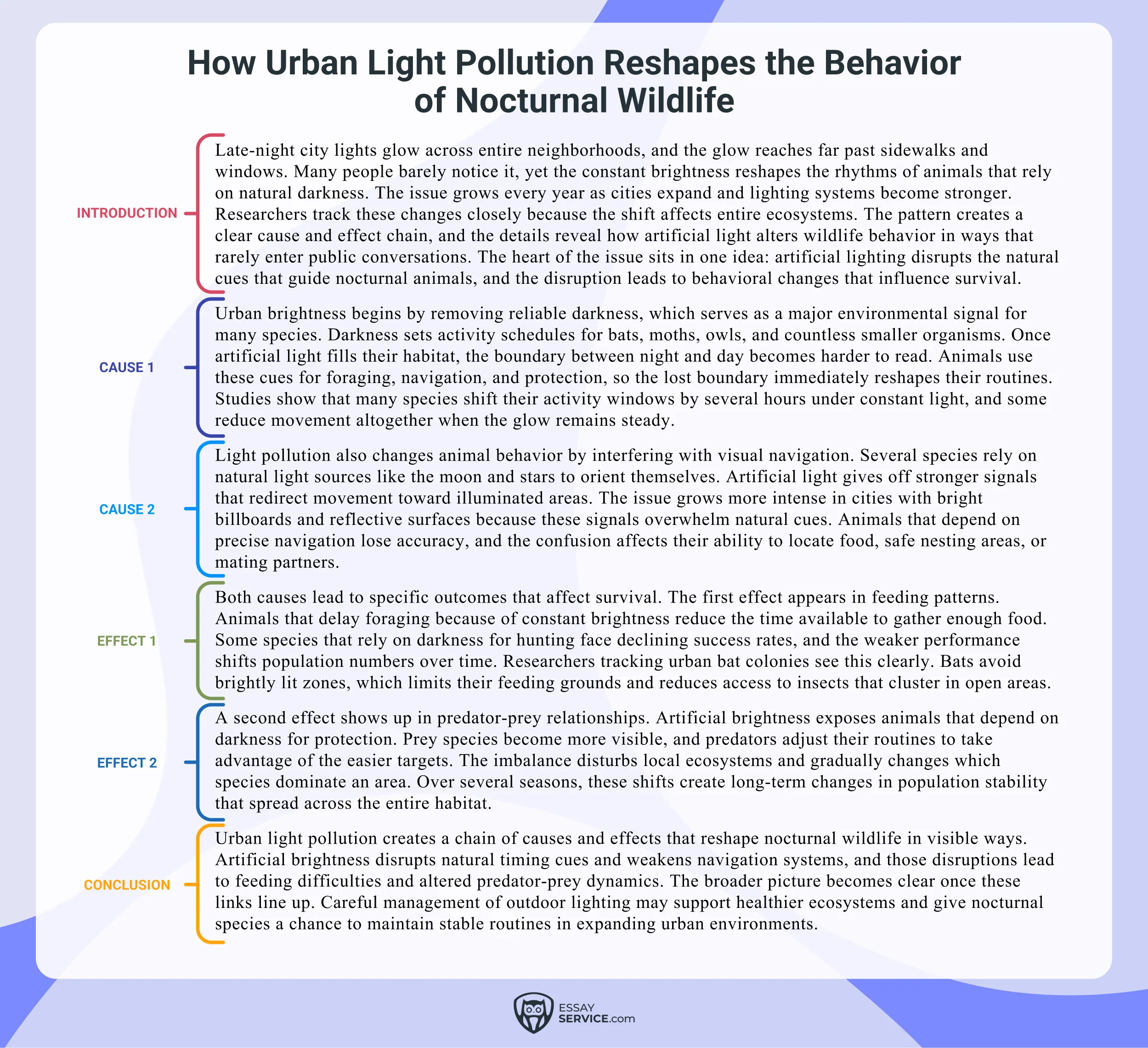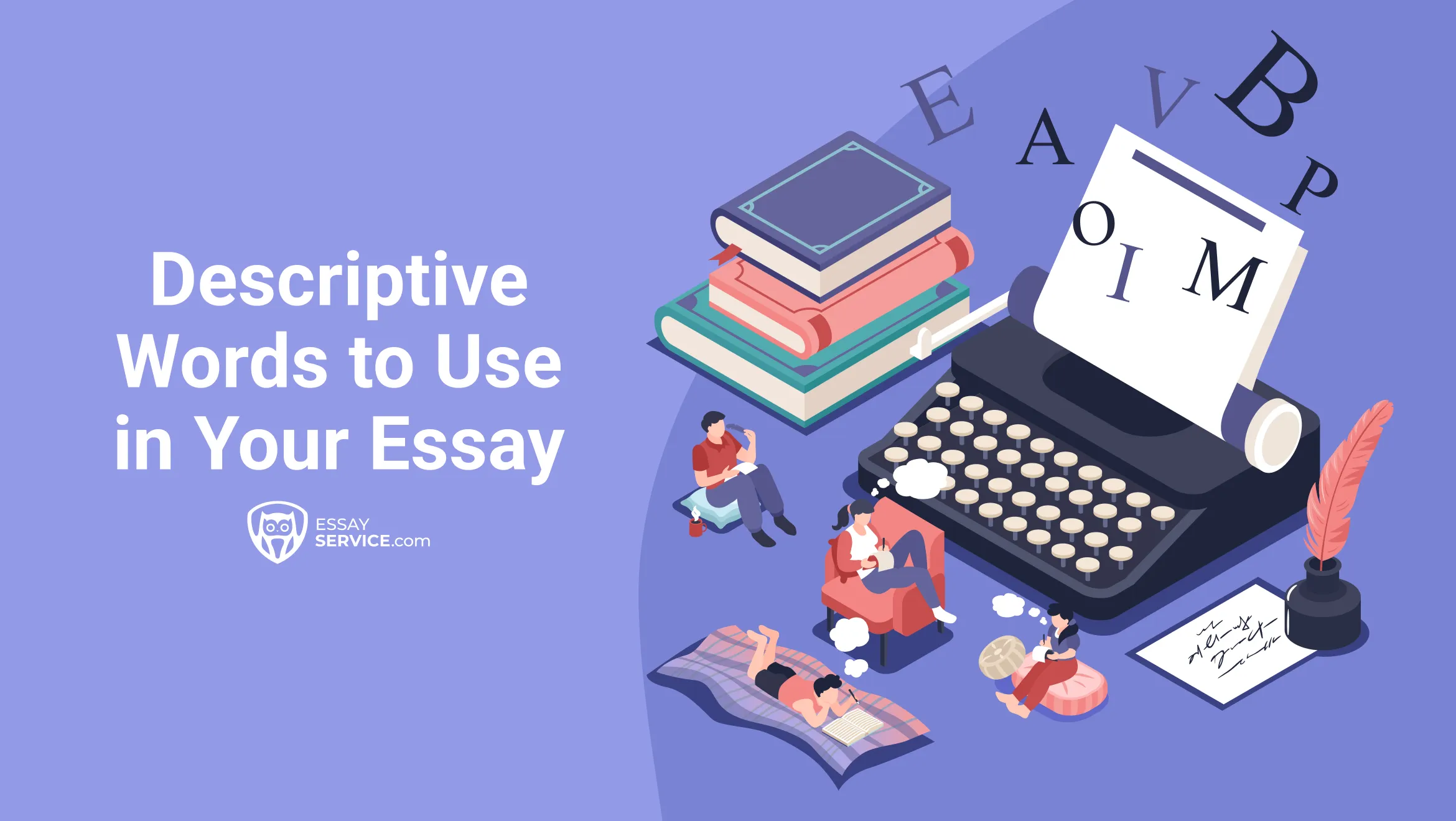Key Takeaways
- A strong cause and effect essay explains why an event happened and shows the outcomes in a clear, logical chain.
- A good structure separates each cause or effect into its own paragraph, supported with reasoning, evidence, and clear transitions.
- Planning matters: outlining before drafting helps you keep the sequence straight and makes the explanation easier to follow.
- Transitional words strengthen the flow by showing how one idea leads into the next and helping the reader stay oriented.
A cause and effect essay is a paper that explains a specific event and analyzes the outcome that follows. The structure focuses on one relationship: something happens, and a certain result appears as a consequence. This kind of paper either focuses on one cause with multiple effects or one effect that stems from multiple causes. The most important thing during the writing process is to establish a logical link between the elements and use supporting evidence to strengthen your points.
Still, it can be tricky to build a well-structured cause and effect essay. If you're short on time or simply need an extra pair of eyes to help you out, reliable essay writers from EssayService can shape an organized paper for you.
What is a Cause and Effect Essay?
A cause and effect essay definition is simple: it is a paper that identifies a cause, examines the consequences of that event, and finally explains why that result appeared. The goal of this paper is to show a direct relationship between the initial factor and the outcome that followed. For example, a rise in class attendance leads to stronger grades because students receive more instruction and feedback.
A logical structure typically includes:
- Cause: A specific factor or action that produces a result.
- Effect: A result that appears because of the cause.
- Logical connection: A clear relationship supported by reasoning and evidence.
- Transitional words: Signals that guide the reader through each step of the relationship.
Students sometimes choose to order essay online when tight deadlines make the academic writing process stressful.
Cause and Effect Essay Structure
Nailing the structure of a cause and effect essay is half the work done. When each piece fits, your essay flows, and it’s easy for readers to follow your logic. Here’s a breakdown that’ll keep you on track:
Introduction
Start by setting the scene. Give readers some background on your topic and why it matters. Make them care! Wrap it up with a clear thesis statement that tells them exactly what cause(s) and effect(s) you’re about to dive into. For example: “Procrastination isn’t just a time-waster; it’s a cycle that leads to stress, sleep loss, and low productivity.”
Body Paragraphs: Start With Causes or Effects
- Each paragraph tackles one main idea. If you’re discussing causes first, each paragraph should focus on a specific reason (like “poor time management” or “fear of failure” for procrastination).
- Use examples to make it relatable. Instead of just saying “Fear of failure leads to procrastination,” add a real example: “Students often put off studying for big exams because they feel unprepared, which snowballs into total overwhelm.”
- Build connections between points. Link each cause to the effect it contributes to, creating a clear chain of events.
Body Paragraphs: Address the Other Side
Each body paragraph should explain a separate outcome of the event you've described earlier (if you chose to cover the causes first). So, if you've been talking about the pattern of procrastination, you now need to show what it leads to, like high stress, declining mental health, and low performance.
Give specific examples here too. “Constantly working under pressure leads to poor memory retention, making students forget the material even if they pulled an all-nighter.”
Conclusion
The cause and effect essay conclusion starts with a short recap of the main ideas. The conclusion circles back to the thesis and completes the line of reasoning that shaped the body sections. A final sentence can widen the view a bit. Cause and effect thinking helps people understand patterns, and that awareness supports clearer decisions in daily life.


Not Sure What Your Professor Wants?
Our professionals can step in and draft essays that check all the right boxes.
Cause and Effect Essay Outline
Let's break down your essay into manageable chunks. This essay outline will keep you organized and make the writing process a whole lot smoother.
- Introduction
- Hook
- Brief background
- Thesis statement presenting the main cause and effect
- Body Paragraph: Cause 1
- Topic sentence introducing the first cause
- Explanation of how this cause works
- Evidence or detail supporting the cause
- Link showing how the cause leads to an effect
- Body Paragraph: Cause 2
- Topic sentence introducing the second cause
- Explanation expanding on why this cause matters
- Evidence or detail supporting it
- Link connecting the cause to the resulting effect
- Body Paragraph: Effect 1
- Topic sentence identifying the first effect
- Explanation describing how the effect appears
- Evidence or detail illustrating the effect
- Body Paragraph: Effect 2
- Topic sentence identifying the second effect
- Explanation describing the impact
- Evidence or detail illustrating the effect
- Conclusion
- Restated thesis
- Short summary of the key causes and effects
- Final thought that highlights the broader point
Download a more detailed, free cause and effect essay outline in PDF form below:
Cause and Effect Essay Examples
Real examples clearly show how to build links between reasons and consequences. Take a look at a real cause and effect essay sample below to see the different ways the parts can play out.

In this section, we've gathered several Cause and effect essay PDF samples for free, so you can download and use them for structural reference.
Tips for Writing a Cause and Effect Essay
Some students jump straight into drafting, yet the strength of this kind of paper usually comes from a clear thought process before the writing even starts. Here are some practical tips for writing cause and effect essay:
- Ask “why” and “what followed” at every step. Those two questions push you past surface-level statements and into a real explanation.
- Look at all possible links before choosing your angle. Many cause and effect essay topics contain several directions, and choosing the most focused chain often leads to a cleaner argument.
- Sketch a quick outline before typing the first sentence. A simple cause and effect essay structure keeps the logic straight and helps you avoid detours that weaken the main point.
- Guide the reader with clear signals. Use transition words that show sequence or consequence. Keep the chain easy to follow and prevent ideas from feeling scattered.
- Revisit the reasoning once the draft is done. A slow read-through usually reveals weak connections or missing steps that need strengthening.
Stress-Free Academic Help
Connect with an expert writer and take a well-deserved break.
Wrapping It All Up
Cause and effect essays work best when the ideas feel connected. When each part flows logically into the next, reasoning lines up in a way that almost feels inevitable to the reader. Once the causes and effects form a strong chain, the entire piece becomes easy to follow.
As a student, you might often have more assignments than time, and that's when pressure can weaken your focus. In moments like this, you can buy an essay service from our platform or check our writing guides to learn how to draft stronger papers.
Frequently Asked Questions
What Is The Purpose Of A Cause And Effect Essay?
The purpose of a cause and effect paper is to build a clear chain of reasoning so the connection between the starting point and the results feels accurate and well supported.
What Is An Example Of A Cause And Effect Essay?
A clear example would be an essay that examines how rising urban noise levels influence student concentration. It identifies noise as the cause, explains the effects on focus and retention, and supports each point with evidence.
What Is The Outline Of A Cause And Effect Essay?
Most outlines include an introduction with a clear thesis statement, a series of body paragraphs that explain the causes or effects in a steady order, and a conclusion that ties the reasoning together.
How Many Paragraphs Is A Cause And Effect Essay?
Many students write five paragraphs for this type of assignment, though topics that involve several steps in the chain may require more room to explain everything clearly.

Jennifer is a student currently pursuing a Journalism major. She oversees the EssayService blog team and uses her journalism skills to ensure all blog posts are accurate, trustworthy, and engaging.
- Cause and Effect Essay - Del Mar College. (2023). https://www.delmar.edu/offices/swc/composition-essay-writing/cause-and-effect.html
- Writing Cause and Effect Papers - TIP Sheet - Butte College. (n.d.). https://www.butte.edu/departments/cas/tipsheets/style_purpose_strategy/cause_effort.html
- CAUSE AND EFFECT. (n.d.). Retrieved November 21, 2025, from https://liberalarts.humber.ca/assets/files/writing_centre/CAUSE%20AND%20EFFECT.pdf
New posts to your inbox
Your submission has been received!




.webp)